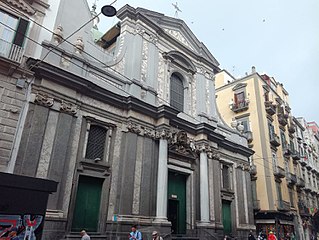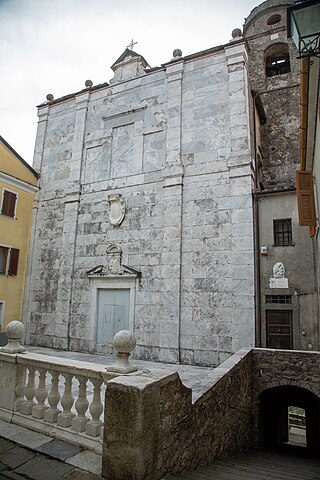
The Pazzi were a powerful family in the Republic of Florence. Their main trade during the fifteenth century was banking. In the aftermath of the Pazzi conspiracy in 1478, members of the family were banished from Florence and their property was confiscated; the family name and coat-of-arms were permanently suppressed by order of the Signoria.

The Basilica di Santa Croce is a minor basilica and the principal Franciscan church of Florence, Italy. It is situated on the Piazza di Santa Croce, about 800 metres southeast of the Duomo, on what was once marshland beyond the city walls. Being the burial place of notable Italians, including those from the Italian Renaissance such as Michelangelo, Galileo, and Machiavelli, as well as the poet Foscolo, political philosopher Gentile and the composer Rossini, it is also known as the Temple of the Italian Glories.

Giunta Pisano was an Italian painter. He is the earliest Italian painter whose name is found inscribed on an extant work. He is best known for his crucifixes.

Sarzana is a town, comune (municipality) and former short-lived Catholic bishopric in the Province of La Spezia, Liguria, Italy. It is 15 kilometres (9 mi) east of La Spezia, on the railway to Pisa, at the point where the railway to Parma diverges to the north. In 2010, it had a population of 21,978.

Renato Bruson is an Italian operatic baritone. Bruson is widely considered one of the most important Verdi baritones of the late 20th and early 21st century.

Piero Calamandrei was an Italian author, jurist, soldier, university professor, and politician. He was one of Italy's leading authorities on the law of civil procedure.

The Basilica of San Michele Maggiore is a Roman Catholic church in Pavia, region of Lombardy, Italy. The building, dating to the 11-12th centuries, is a well-preserved example of the Lombard-Romanesque style.

Renato Castellani was an Italian film director and screenwriter.

Renato Pozzetto is an Italian actor, director, comedian, and singer.

Sarzana Cathedral in Sarzana, Liguria, Italy, is a co-cathedral of the Diocese of La Spezia-Sarzana-Brugnato. It is dedicated to the Assumption of the Virgin Mary. The building is a mixture of the Romanesque and Gothic styles, reflecting the length of the period of its construction, from the early 13th to the late 15th century.

Santa Maria delle Vigne is a Roman Catholic basilica church in Genoa, Italy. It was built in the 10th century. The main altar was completed in 1730 by Giacomo Antonio Ponsonelli. The church is also the final resting place of the leading early Italian composer Alessandro Stradella, who was murdered in 1682.

The Metropolitan Cathedral of Saint Agatha, usually known as the Catania Cathedral, is a Roman Catholic cathedral in Catania, Sicily, southern Italy. It was the seat of the Bishops of Catania until 1859, when the diocese was elevated to an archdiocese, and since then has been the seat of the Archbishops of Catania.

The church of St. Nicholas the Charitable is a church located on via Toledo, almost midway between Piazza Carità and Piazza Dante in Naples, Italy.
The Nastro d'Argento is a film award assigned each year, since 1948, by Sindacato Nazionale dei Giornalisti Cinematografici Italiani, the association of Italian film critics.

La Spezia Cathedral is a Roman Catholic cathedral in La Spezia, Italy. It is the cathedral of the Diocese of La Spezia-Sarzana-Brugnato. It was built between 1956 and 1975, according to designs by Adalberto Libera.

Monastero delle Murate is a former Benedictine convent on Via Ghibellina in Florence, Italy.

Santi Cosma e Damiano is a Roman Catholic church in Alcamo, in the province of Trapani, Sicily, southern Italy.

The Brunelleschi Crucifix is a polychrome painted wooden sculpture by the Italian artist Filippo Brunelleschi, made from pearwood around 1410-1415, and displayed since 1572 in the Gondi Chapel at the church of Santa Maria Novella in Florence. This idealised depiction of the crucifixion of Jesus measures around 170 cm × 170 cm. It is the only surviving wooden sculpture by Brunelleschi: the only other known example, a wooden sculpture of Mary Magdalene at the church of Santo Spirito, was destroyed in a fire in 1471. In his 2002 book, Masaccio e le origini del Rinascimento, the art historian Luciano Bellosi described Brunelleschi's crucifix as "probably the first Renaissance work in the history of art", representing a definitive turn away from the stylised postures of Gothic sculpture and a return to the naturalism of classical sculpture.

The Hero of Venice is a 1941 Italian historical adventure film directed by Carlo Campogalliani and starring Gustav Diessl, Paola Barbara, Rossano Brazzi and Valentina Cortese.

The Oratorio della Compagnia dei Bianchi or Compagnia della Santissima Annunziata is a Baroque-style, Roman Catholic oratory (chapel) located on Via Roma #9 in the mountain-top town of Fosdinovo, province of Massa and Carrara in the region Tuscany, Italy. After a fire destroyed the prior oratory, this white marble building was erected in 1648–1653.



















